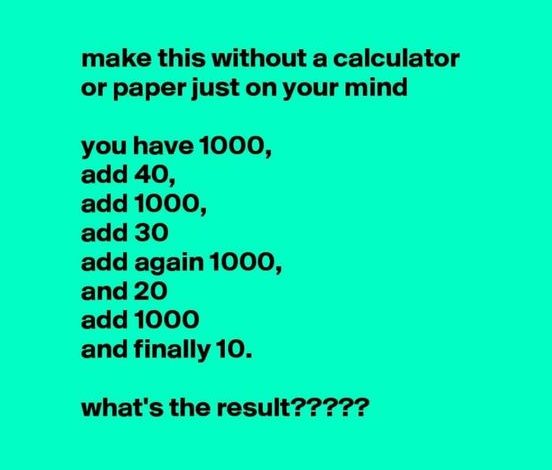
ADVERTISEMENT
The Mental Math Challenge: Uncovering the Trick Behind a Simple Sum
In an age where calculators and smartphones are readily available, mental math often takes a back seat. However, challenges like the one presented in the image can quickly bring us back to our basic arithmetic skills, testing not only our mathematical abilities but also our capacity for focus and attention to detail. At first glance, the problem seems straightforward: a simple sequence of additions that anyone should be able to solve in their head. But as many who attempt this challenge discover, the solution is not as simple as it seems.
The Challenge Explained
The challenge begins by asking you to add a series of numbers mentally, without the aid of a calculator or even a piece of paper. Here’s how the problem is laid out:
- Start with 1000.
- Add 40.
- Add 1000.
- Add 30.
- Add another 1000.
- Add 20.
- Add 1000.
- Finally, add 10.
The sequence seems simple enough, yet it’s designed to trip up even those who are confident in their mental math skills. The final question asks: What’s the result?
Common Mistakes: The Power of Suggestion
Before revealing the correct answer, it’s important to explore why so many people get this wrong. The challenge plays on the way our brains process numbers in sequence. As you add each number, particularly the larger numbers like 1000, your brain starts to settle into a pattern. After several steps, you might think you’ve got the right answer in your head, only to find out you’ve been led astray.
One of the most common mistakes people make is arriving at the sum of 5000. This mistake occurs because the brain tends to group the additions into chunks and miscalculates, particularly when similar numbers (like the 1000s) are repeated multiple times.
ADVERTISEMENT
Breaking It Down Step by Step
To ensure accuracy, let’s break down the problem step by step:
- Start with 1000.
- Add 40: 1000 + 40 = 1040.
- Add 1000: 1040 + 1000 = 2040.
- Add 30: 2040 + 30 = 2070.
- Add another 1000: 2070 + 1000 = 3070.
- Add 20: 3070 + 20 = 3090.
- Add 1000: 3090 + 1000 = 4090.
- Finally, add 10: 4090 + 10 = 4100.
The Correct Answer: 4100
The correct answer is 4100. Despite the seemingly straightforward nature of the problem, many people instinctively come up with 5000 because their brains group the numbers in a way that leads to an incorrect total. This is a classic example of how mental shortcuts, or heuristics, can sometimes lead us astray, especially in a situation where repetition and pattern recognition are involved.
Why Do We Get It Wrong?
The mental error here comes down to a cognitive bias known as the “anchoring effect.” This effect causes us to rely too heavily on the first piece of information we encounter (the first 1000 in this case) and then make incremental adjustments from that anchor. Because we are adding multiples of 1000, our brains may mistakenly group the numbers and lose track of the actual sum, leading to the incorrect result of 5000.
Another factor is the way our working memory handles numbers. When tasked with keeping several figures in mind while performing calculations, it’s easy to mix up steps or combine numbers in a way that feels logical but is mathematically incorrect.
The Importance of Mental Math
Mental math challenges like this one serve as more than just a test of arithmetic; they remind us of the importance of focus and the pitfalls of cognitive biases. In everyday life, we constantly make quick calculations, whether we’re budgeting, cooking, or even just estimating time. Improving our mental math skills can enhance our ability to make these decisions accurately and efficiently.
ADVERTISEMENT
Moreover, exercises like this help keep our brains sharp. In an age where we often rely on technology to do the heavy lifting, maintaining our ability to perform basic calculations mentally is an important aspect of cognitive health.
Conclusion: The Value of Double-Checking
The mental math challenge is a fun and intriguing way to test your arithmetic skills. It also serves as a reminder that even the simplest tasks can be fraught with hidden challenges. The next time you encounter a problem like this, take a moment to break it down step by step, and you’ll likely arrive at the correct answer. And remember, when in doubt, don’t be afraid to double-check your work—it’s a small effort that can save you from falling into a cognitive trap.
So, the next time someone challenges you with this problem, you’ll be ready to confidently answer: The result is 4100.
This article delves into the intricacies of a seemingly simple mental math challenge, exploring why it can be tricky and highlighting the importance of careful calculation. If there are any additional details you’d like to include or specific points you’d like to emphasize, feel free to let me know!
ADVERTISEMENT




